Collection of materials relating to neuro-ophthalmology as part of the Neuro-Ophthalmology Virtual Education Library.
NOVEL: https://novel.utah.edu/
TO
| Title | Creator | Description | Subject | ||
|---|---|---|---|---|---|
| 1 |
 |
Protecting Human Subjects in Biomedical Research | Lisa R. Latchney, MS, CCRC | PowerPoint discussion of the history and development of ethics regulations in health research. | Ethical Issues in Research; Consent |
| 2 |
 |
How to Submit an IRB Application | Elizabeth Frakes, MLIS, AHIP | A general outline of the steps involved in submitting an IRB application for research. | Institutional Review Board (IRB) |
| 3 |
 |
How to Find Funding Sources | Elizabeth Frakes, MLIS, AHIP | Brief description of funding sources and how to find them. | Funding |
| 4 |
 |
Facioscapulohumeral Muscular Dystrophy (FSHD) | Rohith Erukulla; Brooke Johnson | This is an introduction to Facioscapulohumeral Muscular Dystrophy (FSHD) and its causes, presentation, diagnosis, treatment, and ongoing related research. | Dystrophy; Facioscapulohumeral Muscular Dystrophy; FSHD; Myopathy |
| 5 |
 |
Manuscripts: You Can Write These! | Elaine Smolock, PhD | Overview of writing techniques and parts of the manuscript, basic approach to writing results sections, what makes a good introduction, crafting a meaningful discussion, abstract and title suggestions, and how to get your editor's attention. | Writing Techniques |
| 6 |
 |
Neuro-ophthalmic Disorders in Pregnancy: With an Eye to Future Eye Health | Kathleen B. Digre, MD | Presentation covering conditions relevant to neuro-ophthalmology, including vascular disorders that affect vision, Pseudotumor Cerebri Syndrome, venous sinus thrombosis, idiopathic intracranial hypertension, and severe pre-eclampsia and eclampsia. | Pregnancy |
| 7 |
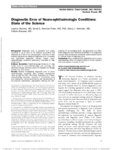 |
Diagnostic Error of Neuro-ophthalmologic Conditions: State of the Science | Leanne Stunkel, MD; David E. Newman-Toker, MD, PhD; Nancy J. Newman, MD; Valérie Biousse, MD | Diagnostic error is prevalent and costly, occurring in up to 15% of US medical encounters and affecting up to 5% of the US population. One-third of malpractice payments are related to diagnostic error. A complex and specialized diagnostic process makes neuro-ophthalmologic conditions particularly vu... | Diagnostic Errors |
| 8 |
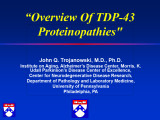 |
Overview of TDP-43 Proteinopathies: Shared Mechanisms Underlying Frontotemporal Lobar Degeneration and Amyotrophic Lateral Sclerosis, The F. E. Bennett Lecture | John Q. Trojanowski, MD, PhD | Slideshow describing condition. | Acquired Ocular Motor Apraxia; Acquired Oculomotor Apraxia; CNS Degeneration; Complete paralysis of voluntary horizontal saccades on command to look left; Frontotemporal Dementia; Impaired pursuit; Inability to make a refixation saccade on command to a target held on the left; Normal voluntary hori... |
| 9 |
 |
The Clinical Examination of Higher Order Visual Function: Syndrome-based Approach - Visual Constructional Apraxia | Victoria S. Pelak, MD; James R. Bateman, MD, MPH; Brianne Bettcher, PhD | Explanation of higher order visual function examination. | Visual Function; Visual Constructional Apraxia |
| 10 |
 |
Functional MRI | Devin D. Mackay, MD | Explanation of using functional MRI in examinations. | Functional MRI |
| 11 |
 |
The Clinical Examination of Higher Order Visual Function: Syndrome-based Approach - Visual Central Achromatopsia | Victoria S. Pelak, MD; James R. Bateman, MD, MPH; Brianne Bettcher, PhD | Explanation of higher order visual function examination. | Visual Function; Visual Central Achromatopsia |
| 12 |
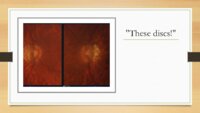 |
Tilted-Disc Syndrome (TDS) - Understanding the Basics | Ahmed Alshaikhsalama; Melanie Truong-Le | This submission is a powerpoint summarizing the literature on a poorly understood disorder known as Tilted Disc Syndrome (TDS). Delving into the fundamental aspects of TDS, this resource meticulously digests complex medical literature to inform readers on the epidemiology, risk factors, complication... | Coloboma; Inferior Crescent; Tilted Disc Syndrome |
| 13 |
 |
Giant Cell Arteritis: Diagnostic Prediction Models, Temporal Artery Biopsy and Epidemiology | Edsel Ing MD, PhD FRCSC MPH CPH MIAD MEd MBA, | Giant cell arteritis (GCA) is the most common primary vasculitis in the elderly and can cause irreversible blindness, aortitis, and stroke. Diagnostic confirmation of GCA usually entails temporal artery biopsy (TABx) - a time-consuming and invasive test, or ultrasound. The primary treatment of GCA i... | Giant Cell Arteritis; Diagnostic Prediction Model; Epidemiology; Temporal Artery Biopsy; Differential Diagnosis |
| 14 |
 |
The Clinical Examination of Higher Order Visual Function: Syndrome-based Approach - Visual Prosopagnosia | Victoria S. Pelak, MD; James R. Bateman, MD, MPH; Brianne Bettcher, PhD | Explanation of higher order visual function examination. | Visual Function; Visual Prosopagnosia |
| 15 |
 |
Genetic Information Nondiscrimination Act of 2008 | Senate and House of Representatives of the United States of America in Congress | Law to prohibit discrimination on the basis of genetic information with respect to health insurance and employment. | Genetics |
| 16 |
 |
The Clinical Examination of Higher Order Visual Function: Syndrome-based Approach - Visual Simultanagnosia | Victoria S. Pelak, MD; James R. Bateman, MD, MPH; Brianne Bettcher, PhD | Explanation of higher order visual function examination. | Visual Function; Visual Simultanagnosia |
| 17 |
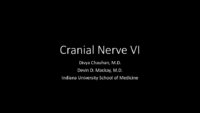 |
The Anatomic Course of Cranial Nerve VI | Divya Chauhan, MD | Overview of the intracranial course of the abducens nerve. | Cranial Nerve VI; Abducens Nerve; Anatomy |
| 18 |
 |
Magnetic Resonance Imaging (MRI) | Devin D. Mackay, MD | Explanation of using magnetic resonance imaging (MRI) in examinations. | Magnetic Resonance Imaging (MRI) |
| 19 |
 |
The Clinical Examination of Higher Order Visual Function: Syndrome-based Approach - Visual Neglect | Victoria S. Pelak, MD; James R. Bateman, MD, MPH; Brianne Bettcher, PhD | Explanation of higher order visual function examination. See accompanying video, Double simultaneous visual field stimulation: https://collections.lib.utah.edu/ark:/87278/s6gn2h9d | Visual Function; Visual Neglect |
| 20 |
 |
Idiopathic Intracranial Hypertension | NANOS | Idiopathic intracranial hypertension (IIH), also called pseudotumor cerebri, is a condition in which there is high pressure in the fluid surrounding your brain, spinal cord, and optic nerves. This can cause headaches and problems with vision. | Idiopathic Intracranial Hypertension; Patient Brochure |
| 21 |
 |
Neuropsychological Assessment | Brianne M. Bettcher, PhD; James R. Bateman, MD, MPH; Victoria S. Pelak, MD | Introduction to neuropsychology and neuropsychological assessments. | Neuropsychological Assessment |
| 22 |
 |
Optic Neuritis | NANOS | In the most common form of optic neuritis, the optic nerve has been attacked by the body's overactive immune system and results in decreased vision. | Optic Neuritis; Patient Brochure |
| 23 |
 |
Pituitary Tumor | NANOS | Pituitary tumors are benign (non-cancerous) overgrowth of cells that make up the pituitary gland (the master gland that regulates other glands in the body). Updated April 2020. | Pituitary Tumor; Patient Brochure |
| 24 |
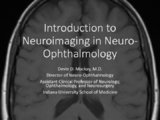 |
Introduction to Neuroimaging in Neuro-Ophthalmology | Devin D. Mackay, MD | Introduction to the subject of neuroimaging in the field of neuro-ophthalmology. | Imaging |
| 25 |
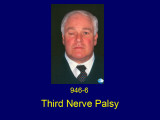 |
Third Nerve Palsy | Shirley H. Wray, MD, PhD, FRCP | The patient is a 50 year old man with Type II Diabetes who presented to an outside hospital in September 1996 with ptosis and an inability to open the right eye. Five months prior to admission (PTA), he had flu-like symptoms with mild fever, sinus congestion and diffuse myalgia in the chest, abdomen... | Ptosis; Unilateral Third Nerve Palsy; Oculomotor Nerve; Meningovascular Syphilis; Heubner's Arteritis; Unilateral Oculomotor Third Nerve Palsy; Third Nerve Microinfarct; Fascicular Third Nerve Palsy |
